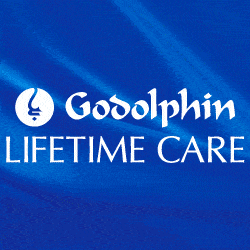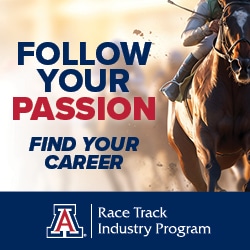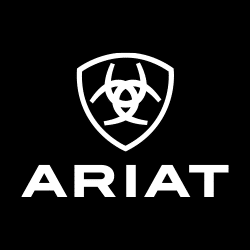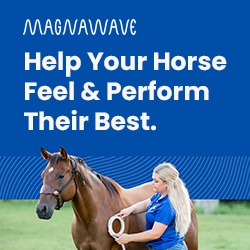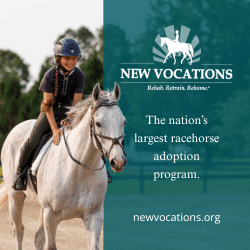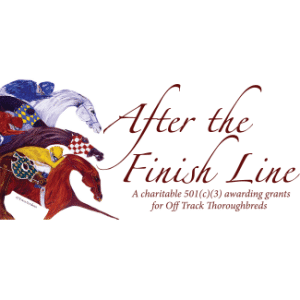First steps when working with a Thoroughbred that’s fresh off the track
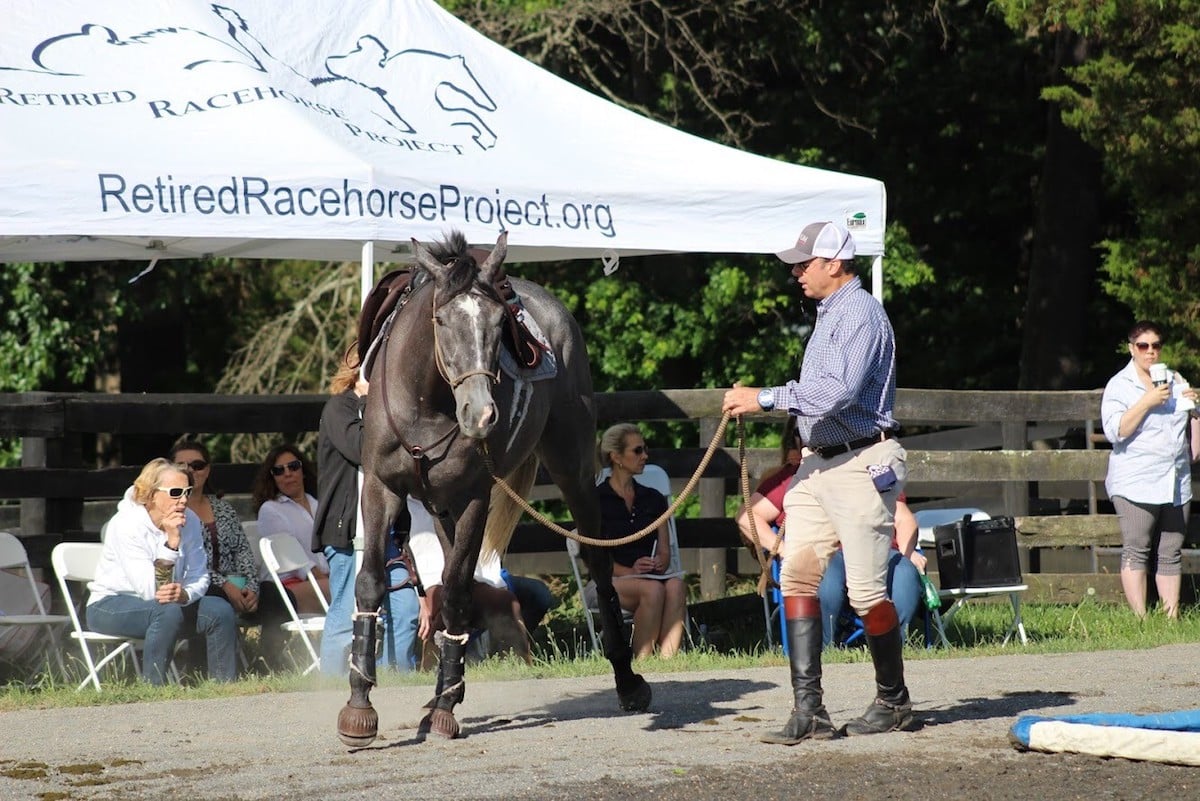
Tom Mansmann works with OTTB Go To The Top. Courtesy Allison Howell
My parents bought me my first off-track Thoroughbred when I was 16. His name was Corsican Crest, or Corky, and we found him through a trainer at Penn National Race Course. Corky (Cresta Rider — Darlin Rebecca, Kentuckian) went on to be a good horse for me. I rode him in Pony Club competitions and competed him regularly into my early 20s. After college, when I decided to be a full-time eventing professional, I started to buy, restart and sell many OTTBs.
My current CCI**** horse, Tactical Maneuver (aka Gucci), is a 2005 OTTB by Thunder Gulch out of Chelle Spendabuck (his registered name is Shykee’s Thunder). I purchased him in 2011 because I wanted to produce my own upper-level horse, and an off-track Thoroughbred was what I could afford.
I already knew Thoroughbreds have an incredible work ethic, but I discovered they also have a sensitive side that speaks to me. The more I refined my training process with them, the more I loved the breed. I’ve found that Thoroughbreds continue to give when other horses won’t. They truly thrive when they feel that they are doing their best for you.
Gucci’s heart was in the game from the beginning, but taking the time to understand and develop him as an individual was the key to our success. I moved him up the levels as I felt he was ready and gave him a few seasons off to become confident in his skills. In 2016 we completed our first CCI**** together at Kentucky, and we jumped around the Land Rover Kentucky Three-Day Event again in 2018.
Gucci is high-strung and had a hard time maintaining weight and muscle in the early years I owned him. Monitoring his diet has been key. I also work closely with my saddle fitter and farrier to make sure he has balanced feet and a comfortable back. Lastly, my equine chiropractor makes sure his body can work optimally as a sport horse. In racing, Thoroughbreds are expected to go fast in a straight line, like an arrow. As sport horses, their bodies need to be more supple and engage in more concentric muscle movements.
Not every OTTB is going to be a four-star eventer, of course. Many professionals retrain Thoroughbreds regularly for pleasure riding, dressage, hunters, jumpers, polo, steeplechase, fox-hunting and even barrel racing. But no matter the discipline or end performance goal, the early process is similar. I spoke to four other professionals who also love the breed about their philosophies and tools for restarting a Thoroughbred in his early days off the track.
Patience and Exposure
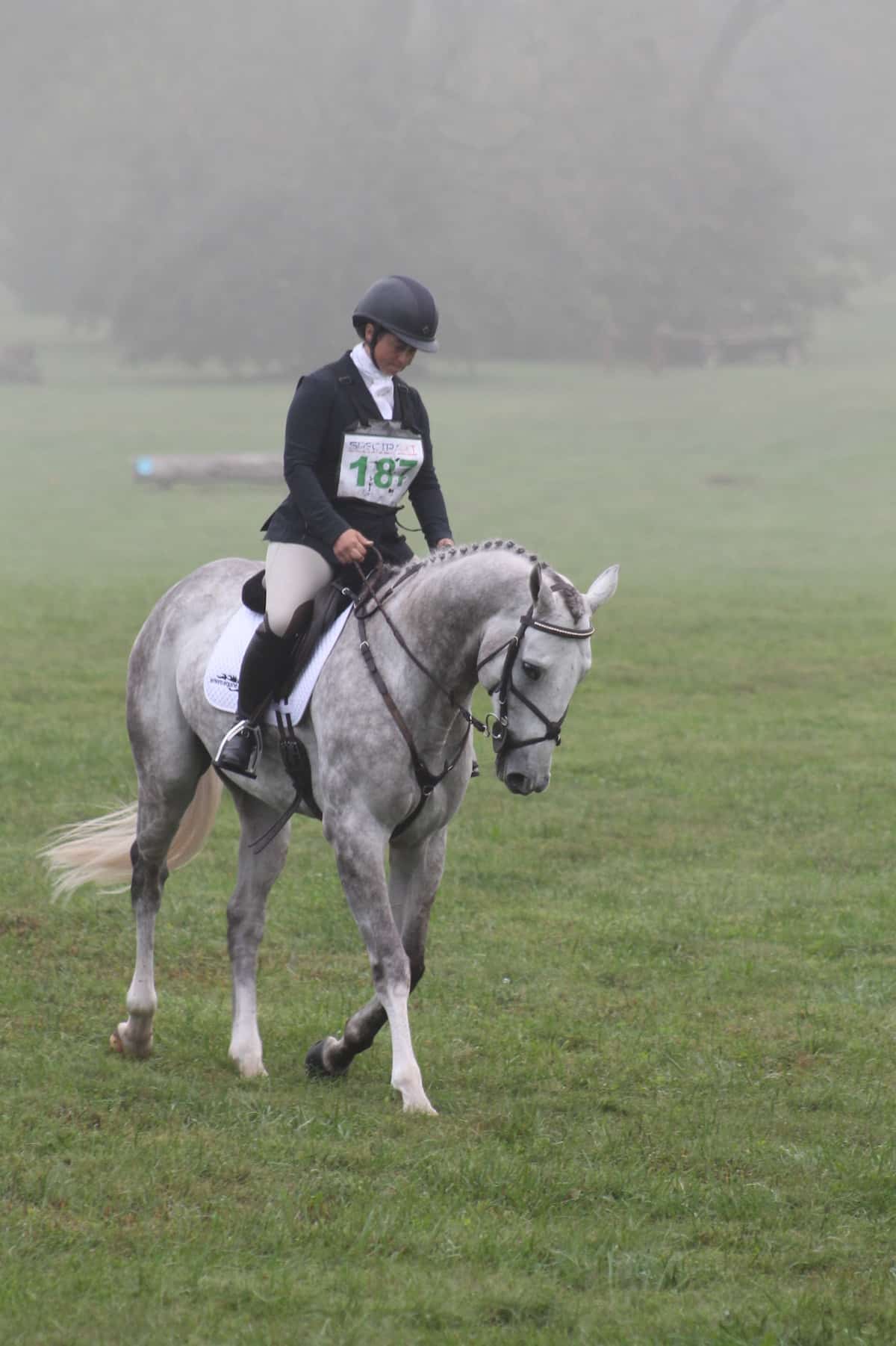
Natalia Neneman, pictured here on Makeover Field Hunter winner Today’s Tom Sawyer, initially focuses on keeping OTTBs balanced and in a consistent rhythm. Stephanie L. Church/The Horse
Natalia Neneman, of Natalia Neneman Eventing, grew up in Park City, Utah, but is now based full-time in Ocala, Florida, where she competes at the three-star level in eventing. In 2016 she began galloping for Classic Bloodstock in Ocala. After a few months of getting to know Neneman, owner Danzel Brendemuehl asked her to prep one horse a year for the Thoroughbred Makeover. Their second Makeover project horse, Today’s Tom Sawyer, won the 2018 Field Hunter division.
While trainers’ philosophies on “letdown” after retirement from racing vary, Natalia likes to give a horse coming off the track six to eight weeks of turnout and just focuses on their nutrition.
“Just being a horse out in the field does them a tremendous amount of good for both their bodies and their minds,” she says.
When she is ready to restart their training, she uses simple equipment — a jump saddle with a breastplate; a plain cavesson bridle with no flash; a big, fat snaffle and a neck strap for good measure. Neneman says her main goal is to get the horse to be relaxed and happy under saddle. During early rides she usually works in a field or an arena with a closed gate to give the horse some boundaries. She wants him to go when she asks him to go and stop when she asks him to stop.
Neneman says she doesn’t worry about putting horses in a frame initially but, rather, focuses on having them keep a consistent rhythm and balance. After a career racing counterclockwise many OTTBs favor the left lead so, once she is cantering, she makes sure to spend time working both leads evenly. When the horse feels confident, she says she graduates to hacking out or riding in bigger areas as often as possible.
While Neneman admits that trainers should approach each horse on a case-by-case basis, she’s found that the more exposure they get, the better. She encourages OTTB owners to take them on field trips, even if it is just to go to a show and eat grass by the ring.
“The more they see, the more they’ll settle in,” she says.
Within a few months of training, Neneman’s goal is to have her horses hacking out alone or in a group, trailering regularly and jumping small courses, including water, banks and ditches. Most importantly, though, she says, “We all need to recognize that no two horses are alike. For me they write their own timeline and we go according to that. No need to rush.”
New Situations and Self-Carriage
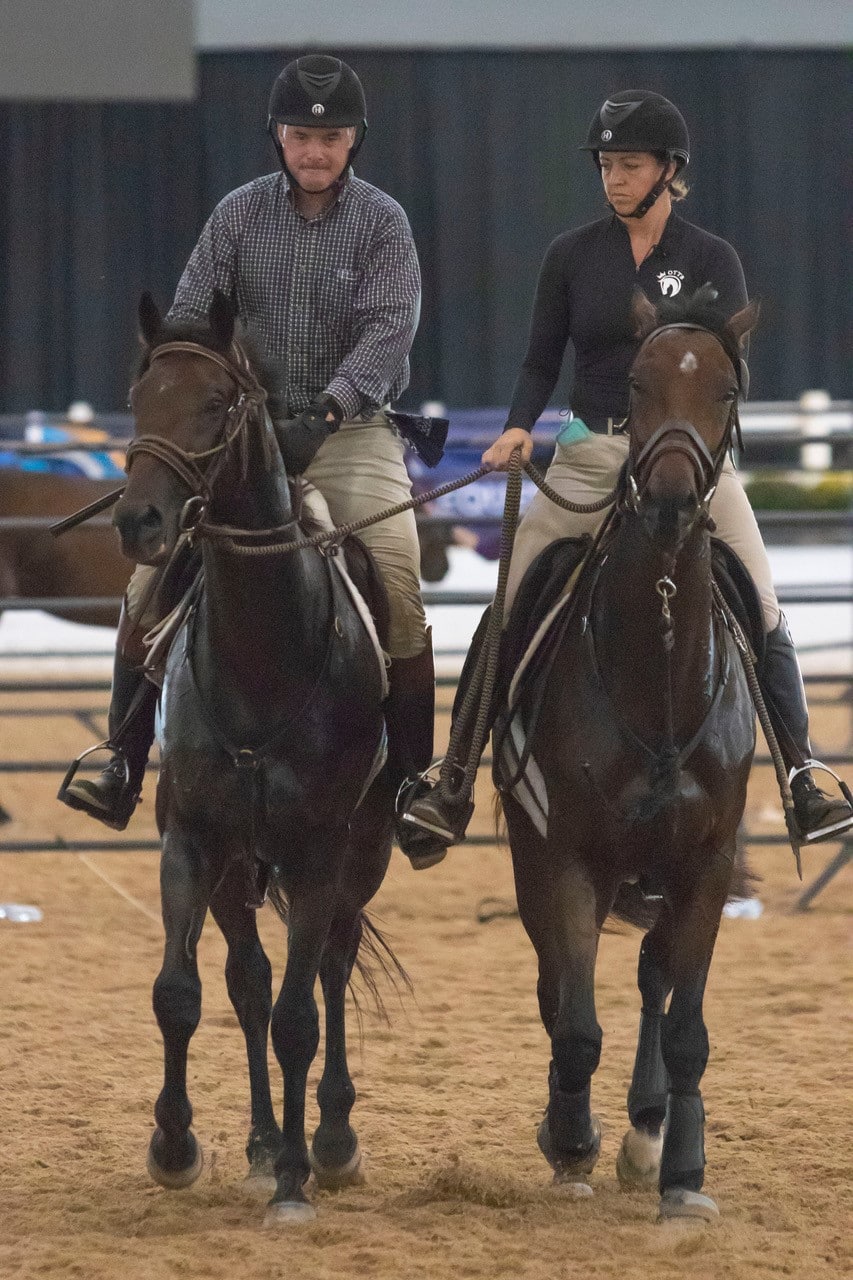
Clare and Tom Mansmann demonstrated their OTTB-starting skills in the 2018 Makeover Master Class. Courtesy Justine Howell
Clare and Tom Mansmann, of Pacific Farms Inc., are based in Middleburg, Virginia. Their background is mainly in eventing, which is how they started working with off-track Thoroughbreds. “It’s what we had to ride back in the day,” says Clare, who exercised horses on the track for several years, while Tom exercised steeplechase horses. Recently they took three horses to the 2018 RRP Makeover, placing in both Field Hunters and Working Ranch with Tiz Solo Vino.
When horses first arrive at their farm, the Mansmanns try to learn as much about their histories as possible — particularly if a horse has any old injuries or health issues they need to be aware of. They describe their farm as having a low-stress atmosphere, and they say they treat all their horses — even those right off the track — like regular horses, putting them on a normal turnout schedule. They feed plenty of quality hay to keep the gastrointestinal tract heathy (alfalfa for the horses for whom its deemed appropriate), and they schedule an initial farrier and dental assessment for each horse.
Before their first ride, the Mansmanns do groundwork to make sure the horse can move off both sides and understand clear pressure and release. They also practice tying the horses in different locations all over the farm, even when there are horses working around them.
“They hang out a lot,” says Clare.
She says another part of their program is ponying their new recruits. They lead them all over the countryside, through creeks, across roads and over logs and jumps. Like Neneman, the Mansmanns start taking their horses on field trips as soon as possible, even if only to do nothing at the destination, so that getting on the trailer and visiting new places feels like something regular to them, rather than a special occasion. Because of all this, says Clare, by the time she or her husband hops on a horse, they know a lot about the mount’s temperament and reactions.
Once the horses are under saddle, the Mansmanns take everything day by day. Clare says they focus not on a time frame but, rather, the number of rides a horse has had, and where that horse is from the beginning of the ride to the end. Sometimes, in the first few months of adapting to turnout and the elements, OTTBs will develop hoof abscesses, taking them out of training for a week or so. Clare says this is fine and often a normal part of the transition.
During rides they focus on moving forward and laterally off the leg, creating suppleness in the intercostal muscles that are between the ribs and having the horse hold his pace with as little rein contact as possible, even over a course of small jumps. Only then do they start to move the horses into contact. Even though the process is slow, the Mansmanns believe this self-carriage is important for a horse’s future with a potentially less-experienced rider.
“They need to learn to carry and care for themselves, so they don’t worry if they wind up with a loving owner who makes some mistakes,” Clare says.
Building Blocks and Progress
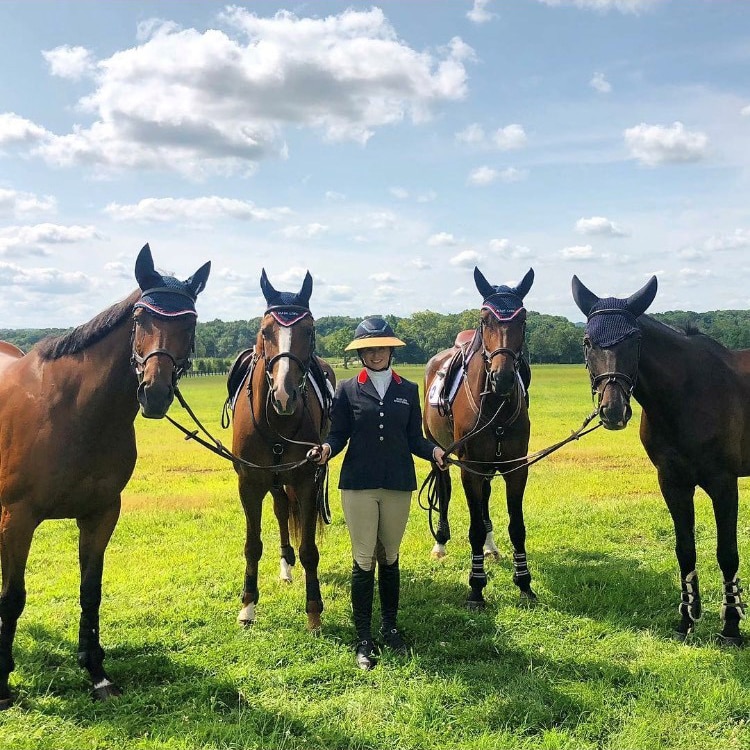
Gillian Beale King has had plenty of success with OTTBs in the hunters and jumpers. Courtesy Main Line Sport Horses
Gillian Beale King, of Main Line Sport Horses, is based in Malvern, Pennsylvania. She grew up riding both eventers and hunter/jumpers at her parents’ respective stables. In 2014 she branched out on her own. Some of her successes with OTTBs have been wins at HITS and other A-rated hunter and jumper shows, as well as competing in steeplechase in the Maryland Hunt Cup.
When Beale King gets a new OTTB into her program, she takes the first few weeks slowly, keeping in mind that “this is a major adjustment for even the most easygoing of horses,” she says.
She initially turns the horse out in a round pen before moving him to a larger grass paddock. She also likes to feed beet pulp and alfalfa to help put weight on the horse.
Beale King emphasizes that getting to know your horse from the ground is an important aspect of OTTB horsemanship. For her first few rides she uses a neck strap and a double-jointed D-ring snaffle so she can assess the horse’s mouth and decide what bit would best suit him moving forward. Each horse is different, and some progress faster than others, she says.
Beale King says she also likes to have each building block of the horse’s training fully in place before moving on to the next. In early rides, for instance, she focuses on stretching the horse equally in both directions at the walk and the trot.
“Naturally, OTTBs tend to be a little more supple to the left,” she says. So she starts working with their more supple side and then moves to their stiff side.
“The most important thing for me is to see progress of some sort,” Beale King says. “If I hit a wall with a horse, from nerves or a lack of understanding, I’ll go back and work on the basics to help them keep improving.”
She says she takes her OTTBs on low-stress field trips to other farms and then to shows, but, like our other sources, initially just to school or ride around, not compete. She wants them to learn that outings are fun and not stressful.
After a few months of training, Beale King aims for her horses to maintain consistent contact with the bit and adjust their stride without rushing.
Within her diverse program, she has seen the benefit of an OTTB finding its niche. “I have had numerous horses come to me to be trained or sold as hunters or jumpers that make a career switch to a discipline that they are happier and more successful in,” Beale King says. “They will far exceed your hopes if they love what they are doing.”
Putting it All Together
In speaking to these four trainers from different disciplines, I appreciated the similar basics of their programs. Each believes nutrition, health and keeping an OTTB happy and engaged are important pieces of the retraining puzzle. They also each emphasized low-key exposure right from the beginning. Taking things day by day and allowing each horse time to develop his own balance and self-carriage under saddle was the dominant theme. Above all, I appreciated that each trainer spoke about listening to their horse. In my experience with the OTTBs I have worked with, and Gucci in particular, there is a balance between setting goals and taking the time to enjoy the (sometimes frustrating) process and progress of training. In the end, the most important element of being a good horseman is the relationship we have with our horses.

